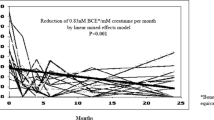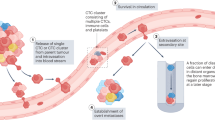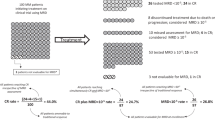Abstract
It is unclear whether disseminated tumour cells detected in bone marrow in early stages of solid cancers indicate a subclinical systemic disease component determining the patient's fate or simply represent mainly irrelevant shed cells. Moreover, characteristics differentiating high and low metastatic potential of disseminated tumour cells are not defined. We performed repeated serial bone marrow biopsies during follow–up in operated gastric cancer patients. Most patients with later tumour relapse revealed either an increase or a constantly high number of tumour cells. In contrast, in patients without recurrence, either clearance of tumour cells or negative or low cell counts were seen. Urokinase plasminogen activator (uPA)–receptor expression on disseminated tumour cells was significantly correlated with increasing tumour cell counts and clinical prognosis. These results demonstrate a systemic component in early solid cancer, indicated by early systemically disseminated tumour cells, which may predict individual disease development.
This is a preview of subscription content, access via your institution
Access options
Subscribe to this journal
Receive 12 print issues and online access
$209.00 per year
only $17.42 per issue
Buy this article
- Purchase on Springer Link
- Instant access to full article PDF
Prices may be subject to local taxes which are calculated during checkout
Similar content being viewed by others
References
Brisco, M.J. et al. Outcome prediction in childhood acute lymphoblastic leukaemia by molecular quantification of residual disease at the end of induction. Lancet 343, 196–199 (1994).
Yokota, S. et al. Use of polymerase chain reactions to monitor minimal residual disease in acute lymphoblastic leukemia patients. Blood 77, 331–339 (1991).
Riethmueller, G. & Johnson, J. Monoclonal antibodies in the detection and therapy of micrometastatic epithelial cancer. Curr. Opin. Immun. 4, 647–655 (1992).
Osborne, M.P. & Rosen, P.P. Detection and management of bone marrow micrometastases in breast cancer. Oncology 8, 25–31 (1994).
Moss, T.J. et al. Prognostic value of immunocytologic detection of bone marrow metastases in neuroblastoma. NewEngl. J. Med. 324, 219–226 (1991).
Lindemann, F., Schlimok, G., Dirschedl, P., Witte, J. & Riethmueller, G. Prognostic significance of micrometastatic tumor cells in bone marrow of colorectal cancer patients. Lancet 340, 685–689 (1992).
Schlimok, G. et al. Micrometastatic cancer cells in bone marrow: In vitro detection with anti-cytokeratin and in vivo labeling with anti-17-lA monoclonal antibodies. Proc. natn. Acad. Set. U.S.A. 84, 8672–8676 (1987).
Ghosh, A.K. et al. Detection of metastatic tumour cells in routine bone marrow smears by immunoalkaline phosphatase labelling with monoclonal antibodies. Brit J. Haematol. 61, 21–30 (1985).
Heiss, M.M. et al. Detection of cytokeratin-positive cells in bone marrow used as tumor marker in gastric cancer patients. in Tumor Associated Antigens, Oncogenes, Receptors, Cytokines in Tumor Diagnosis and Therapy at the Beginning of the Nineties, Cancer of the Breast — State and Trends in Diagnosis and Therapy (ed. Klapdor, R.) 471–473 (Zuckschwerdt, Munich, New York, 1992).
Pantel, K. et al. Differential expression of proliferation-associated molecules in individual micrometastatic carcinoma cells. J. natn. Cancer Inst. 85, 1419–1423 (1993).
Berger, U. et al. The relationship between micrometastasis in the bone marrow, histopathologic features of the primary tumor in breast cancer and prognosis. Am. J. clin. Pathol. 90, 1–6 (1988).
Cote, R.J., Rosen, P.P., Lesser, M.L., Old, L.J. & Osborne, M.P. Prediction of early relapse in patients with operable breast cancer by detection of occult bone marrow micrometastases. J. clin. Oncol. 9, 1749–1756 (1991).
Riesenberg, R. et al. Immunocytochemical double staining of cytokeratin and prostate specific antigen in individual prostatic tumour cells. Histochemistry 99, 61–66 (1993).
Jauch, K.W., Gruetzner, U., Heiss, M.M., Funke, I. & Schildberg, F.W. Prognostic significance of early disseminated tumor cells in bone marrow of patients with gastric cancer, in First Intl. Gastric Cancer Congr., Kyoto, Japan Mar. 29–Apr. 1, 1995 (eds Nishi, M. et al.) 1021–1025 (Monduzzi Edi, Bologna, 1995).
Mansi, J.L. et al The fate of bone marrow micrometastases in patients with primary breast cancer. J. clin. Oncol. 7, 445–449 (1989).
Fidler, I. & Kripke, M.L. Metastasis results from pre-existing variant cells within a malignant tumor. Science 197, 893–895 (1977).
Dvorak, H.F., Wounds that do not heal. New Engl. J. Med. 315, 1650–1659 (1986).
Duffy, M.J. The role of proteolytic enzymes in cancer invasion and metastasis. Clin. exp. Metastasis 10, 145–155 (1992).
Ossowski, L., Clunie, G., Masucci, M.T. & Blasi, F. In vivo paracrine interaction between urokinase and its receptor: Effect on tumor cell invasion. J. Cell Biol. 115, 1107–1112 (1991).
Blasi, F. Urokinase and urokinase receptor: A paracrine/autocrine system regulation cell migration and invasiveness. BioEssays 15, 105–111 (1993).
Heiss, M.M. et al. Tumor-associated proteolysis and prognosis: New functional risk factors in gastric cancer defined by the urokinase-type plasminogen activator system. J. clin. Oncol. 13, 2084–2093 (1995).
Nekarda, H. et al. Prognostic impact of urokinase-type plasminogen activator and its inhibitor PAI-1 in completely resected gastric cancer. Cancer Res. 54, 2900–2907 (1994).
Duffy, M.J. et al. Urokinase-plasminogen activator, a new and independent prognostic marker in breast cancer. Cancer Res. 50, 6827–6829 (1990).
Moll, R., Franke, W.W., Schiller, D.L., Geiger, B. & Krepler, R. The catalogue of human cytokeratins: Pattern of expression in normal epithelia, tumors and cultured cells. Cell 31, 11–24 (1982).
Breimann, L., Friedmann, J.H., Ohlsen, R.A. & Sone, C.J. Classification and Regression Trees (Waelswoth, Belmont, California, 1984).
Fazioli, F. & Blasi, F. Urokinase-type plasminogen activator and its receptor: New targets for anti-metastatic therapy. Trends Pharmac. Sci. 15, 25–29 (1994).
Paget, S. Distribution of secondary growths in cancer of the breast. Lancet 1, 571 (1889).
Wong, K.F., Chan, J.K. & Ma, S.K. Solid tumor with initial presentation in the bone marrow: A clinicopathologic study of 25 adult cases. Hematol.-Oncol. 11, 35–42 (1993).
Frost, P., Raber, M.N. & Abbruzzese, J.L. Unknown primary tumors as a unique clinical and biological entity: A hypothesis. Cancer Bull. 41, 139–141 (1989).
Cordell, J.L. et al. Immunoenzymatic labelling of monoclonal antibodies using immune complexes of alkaline phosphatase and monoclonal antialkaline phosphatase (APAAP complexes). J. Histochem. Cytochem. 32, 219–229 (1984).
Dixon, W.J. et al. BMDP Statistical Software (Univ. California Press, Los Angeles, 1985).
Kaplan, E.L. & Meier, P. Nonparametric estimation from incomplete observation. J. Am. stat. Assoc. 53, 457–481 (1958).
Cox, D.R. Regression models and life tables. J. R. stat Soc. (B) 34, 187–220 (1972).
Author information
Authors and Affiliations
Rights and permissions
About this article
Cite this article
Heiss, M., Allgayer, H., Gruetzner, K. et al. Individual development and uPA–receptor expression of disseminated tumour cells in bone marrow: A reference to early systemic disease in solid cancer. Nat Med 1, 1035–1039 (1995). https://doi.org/10.1038/nm1095-1035
Received:
Accepted:
Issue Date:
DOI: https://doi.org/10.1038/nm1095-1035
This article is cited by
-
Circulating tumour cells for early detection of clinically relevant cancer
Nature Reviews Clinical Oncology (2023)
-
The force awakens: metastatic dormant cancer cells
Experimental & Molecular Medicine (2020)
-
Epithelial-to-mesenchymal transition in cancer: complexity and opportunities
Frontiers of Medicine (2018)
-
Hypoxia and Bone Metastatic Disease
Current Osteoporosis Reports (2017)
-
Tumor metastasis: moving new biological insights into the clinic
Nature Medicine (2013)



